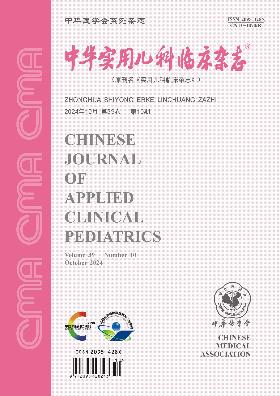Drug resistance and molecular epidemiology of Acinetobacter baumannii isolated from pediatric patients
Q4 Medicine
引用次数: 0
Abstract
Objective To analyze the drug resistance and molecular epidemiological characteristics of Acinetobacter baumannii isolated from pediatric patients. Methods Acinetobacter baumannii isolated from patients hospitalized in Inner Mongolia Medical University Affiliated Hospital from January 2016 to June 2018 was collected.Vitek-2 Compact automatic microbiological identification and drug sensitivity analysis system was used to identify and test the drug sensitivity of Acinetobacter baumannii isolates, and pulse field gel electrophoresis (PFGE) and multilocus sequence analysis (MLST) were applied to the homology analysis of the strains. Results A total of 94 clinical isolates of Acinetobacter baumannii were collected, of which 42 strains were isolated from pediatric patients and 52 strains from adult patients.The drug resistance rates of pediatric isolates to Imipenem, and Meropenem and Tigecycline were 7.1%, 7.1% and 0, respectively, and the drug resistance rates of adult isolates to these 3 antibiotics were 67.3%, 54.8%, and 5.5%, respectively.The results of PFGE typing showed that 94 strains were divided into 49 genotypes (X1-X49 type), 52 adult strains were distributed in 22 genotypes, and 42 pediatric strains were distributed in 33 genotypes.The dominant genotype was X23 (21 strains, 22.3%), of which 18 strains(85.7%) were adult isolates and 3 strains (14.3%) were children isolates.The drug resistance rate of X23 genotypes to carbapenems was 100%, which was significantly higher than that of other genotypes.The results of MLST genotyping showed that X23 genotype was ST195, which belonged to clonal complex(CC92) clone. Conclusions The overall drug resistance rate of Acinetobacter baumannii isolates in Inner Mongolia Medical University Affiliated Hospital was significantly lower than that of adult isolates, and the diversity of genotypes was obvious.The dominant genotypes of the strains belongs to the CC92 clone population, and is the dominant clone strain in many places of our country. Key words: Pediatrics; Acinetobacter baumannii; Drug resistance; Homology analysis小儿鲍曼不动杆菌耐药性及分子流行病学研究
目的分析小儿鲍曼不动杆菌的耐药性及分子流行病学特征。方法收集2016年1月至2018年6月内蒙古医科大学附属医院住院患者分离的鲍曼不动杆菌。采用Vitek-2 Compact全自动微生物鉴定及药敏分析系统对鲍曼不动杆菌分离株进行药敏鉴定和检测,采用脉冲场凝胶电泳(PFGE)和多位点序列分析(MLST)对菌株进行同源性分析。结果共检获鲍曼不动杆菌临床分离株94株,其中小儿分离株42株,成人分离株52株。小儿分离株对亚胺培南、美罗培南和替加环素的耐药率分别为7.1%、7.1%和0%,成人分离株对这3种抗生素的耐药率分别为67.3%、54.8%和5.5%。PFGE分型结果显示,94株菌株分为49个基因型(X1-X49型),52株成人菌株分布在22个基因型中,42株儿科菌株分布在33个基因型中。优势基因型为X23(21株,占22.3%),其中成人分离株18株(85.7%),儿童分离株3株(14.3%)。X23基因型对碳青霉烯类药物的耐药率为100%,显著高于其他基因型。MLST分型结果显示,X23基因型为ST195,属于克隆复合体(CC92)克隆。结论内蒙古医科大学附属医院鲍曼不动杆菌分离株总体耐药率显著低于成人分离株,且基因型多样性明显。菌株的优势基因型属于CC92无性系群体,是我国多地的优势无性系菌株。关键词:儿科学;鲍曼不动杆菌;耐药;同源性分析
本文章由计算机程序翻译,如有差异,请以英文原文为准。
求助全文
约1分钟内获得全文
求助全文
来源期刊

中华实用儿科临床杂志
Medicine-Pediatrics, Perinatology and Child Health
CiteScore
0.60
自引率
0.00%
发文量
14243
期刊介绍:
Chinese Journal of Applied Clinical Pediatrics ( semi-monthly ) is a core journal of paediatrics under the supervision of China Association for Science and Technology, sponsored by Chinese Medical Association and undertaken by Xinxiang Medical College. Founded in 1986, it is openly circulated both at home and abroad. The journal has several columns, such as Expert Forum, Experimental Research and Paediatric Surgery, which are mainly for paediatric medical workers and medical researchers in hospitals. Its purpose is to reflect the new theories and technologies in paediatric medicine and scientific research at home and abroad, and to promote academic exchanges.
Chinese Journal of Applied Clinical Pediatrics is a source journal of China Science Citation Database (CSCD), a core journal of Peking University, a source journal of Chinese science and technology paper statistics (China Science and Technology Core Journals), a core academic journal of RCCSE, a high-quality scientific and technical journal of China, a high-quality scientific and technical journal of China Association for Science and Technology, and a high-quality scientific and technical journal of China Biomedical Science and Technology Association. We have been published in China Biomedical Literature Database (SinoMed), China Knowledge Network, Wanfang Data Knowledge Service Platform, China Academic Journal Abstracts, Scopus Database, Chemical Abstracts (USA), Japan Science and Technology Agency (JSTA) Database, Copernicus Abstracts (Poland), Abstracts of the Centre for Agricultural and Biological Sciences (CABS) of the United Kingdom, Cambridge Scientific Abstracts ProQuest Database, WHO Medical Journal of the Western Pacific Region (WMPR), and WHO Medical Journal of the Western Pacific Region (WMPR) of the United States. We have been included in dozens of authoritative databases at home and abroad, such as WHO Western Pacific Region Index of Medicine (WPRIM), Ullrich's Guide to Periodicals, and so on.
 求助内容:
求助内容: 应助结果提醒方式:
应助结果提醒方式:


